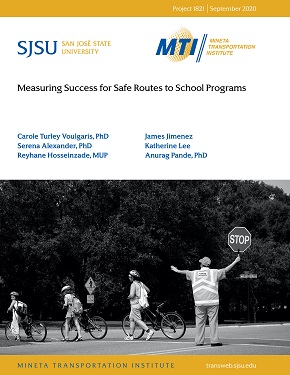- 408-924-7560
- mineta-institute@sjsu.edu
- Donate
Measuring Success for Safe Routes to School Programs
Safe Routes to School (SRTS) programs aim to increase the share of students who commute to school by active modes (e.g., walking and cycling). The goal of this work was to assess the effectiveness of SRTS programs. Towards that end, we analyzed the California Household Travel Survey (CHTS) data from the four counties in the San Francisco Bay area. We estimated logistic regression model(s) to predict the likelihood that a child commutes to school by active modes based on the presence of an SRTS program and controlling for individual, household, and tract characteristics. Findings indicate that longer trip distance and race (relative to White students) are associated with reduced rates of active travel to school. The presence of SRTS programs mitigates these differences. We conclude that the effect of SRTS programs might best be described as reducing barriers to active school travel, rather than simply increasing the likelihood of using active modes. We also interviewed parents and school administrators about the SRTS programs. The interviewees noted the importance of social connections among students and their families as an advantage of SRTS programs in addition to the health, economic, and environmental benefits. The barriers to more active travel to school cited by the interviewees included the challenge of implementing SRTS programs consistently over a sustained period and the lack of physical infrastructure that feels safe to the students and their parents.
CAROLE TURLEY VOULGARIS, PhD
Carole Turley Voulgaris is an Assistant Professor of Urban Planning at Harvard University’s Graduate School of Design. Prior to that, she was an Assistant Professor of Civil Engineering at California Polytechnic State University.
SERENA ALEXANDER, PhD
Serena Alexander is an Assistant Professor of Urban and Regional Planning at San Jose State University.
REYHANE HOSSEINZADE, MUP
Reyhane Hosseinzade is an MS student in the Urban and Regional Planning department at San José State University.
JAMES JIMENEZ
James Jimenez is an MS student at the City and Regional Planning Department at California Polytechnic State University.
KATHERINE LEE
Katherine Lee is an undergraduate Civil Engineering student at California Polytechnic State University.
ANURAG PANDE, PhD
Anurag Pande is a Professor of Civil Engineering at California Polytechnic State University. At Cal Poly, he also serves as the faculty liaison for community engagement to foster partnerships between Cal Poly and nearby communities and non-profit organizations.
-
Contact Us
San José State University One Washington Square, San Jose, CA 95192 Phone: 408-924-7560 Email: mineta-institute@sjsu.edu






